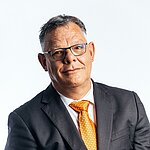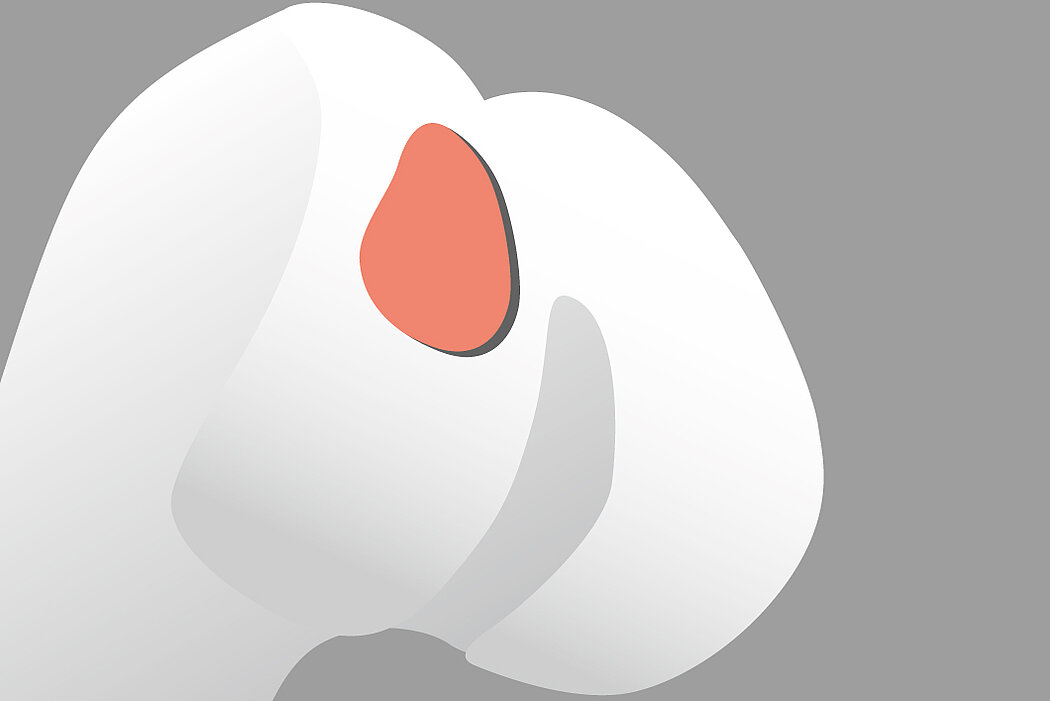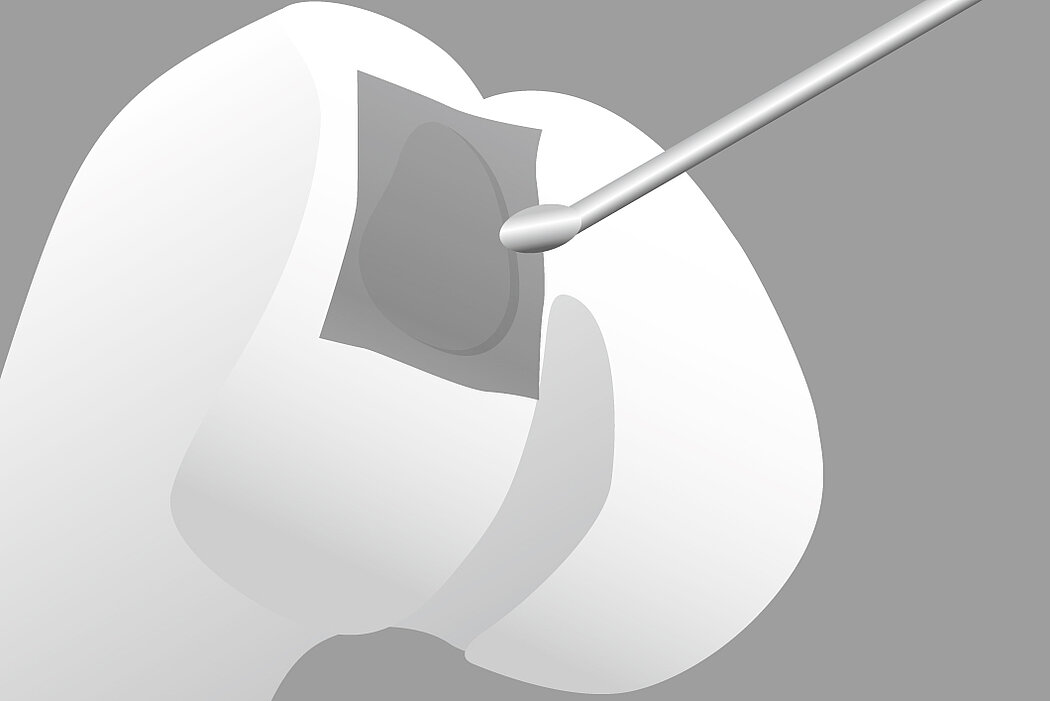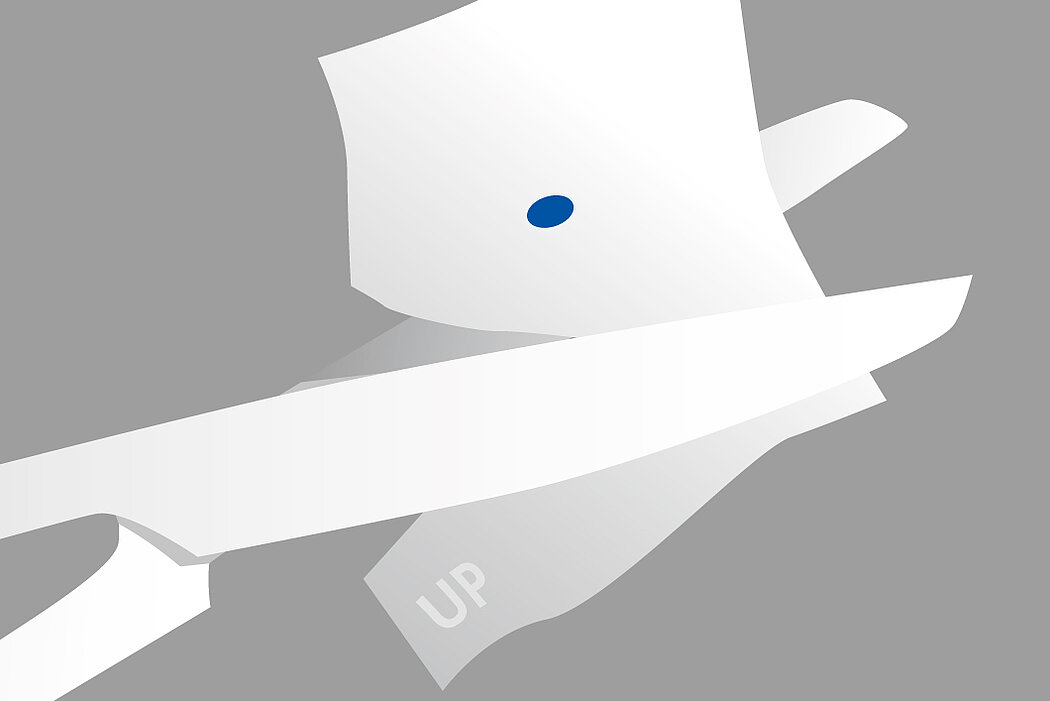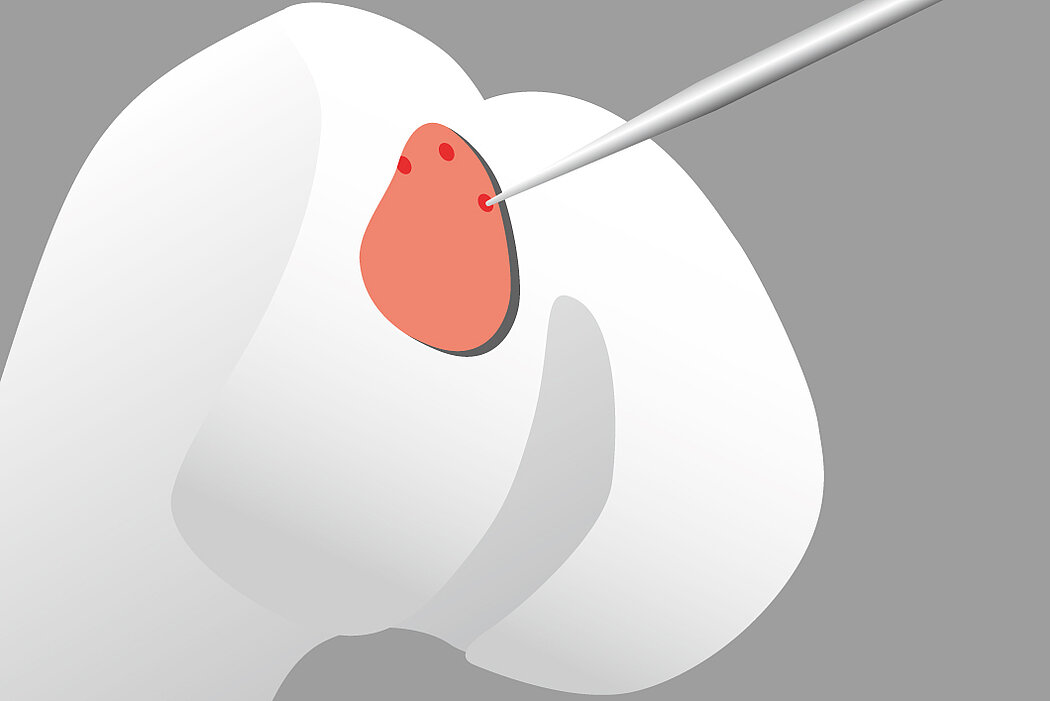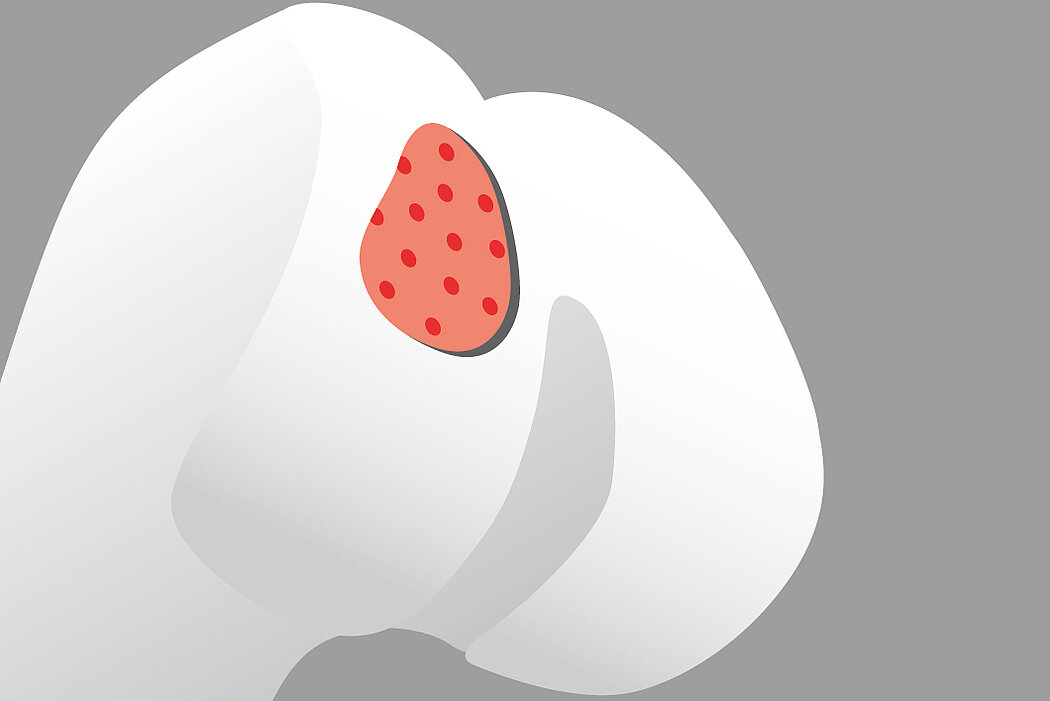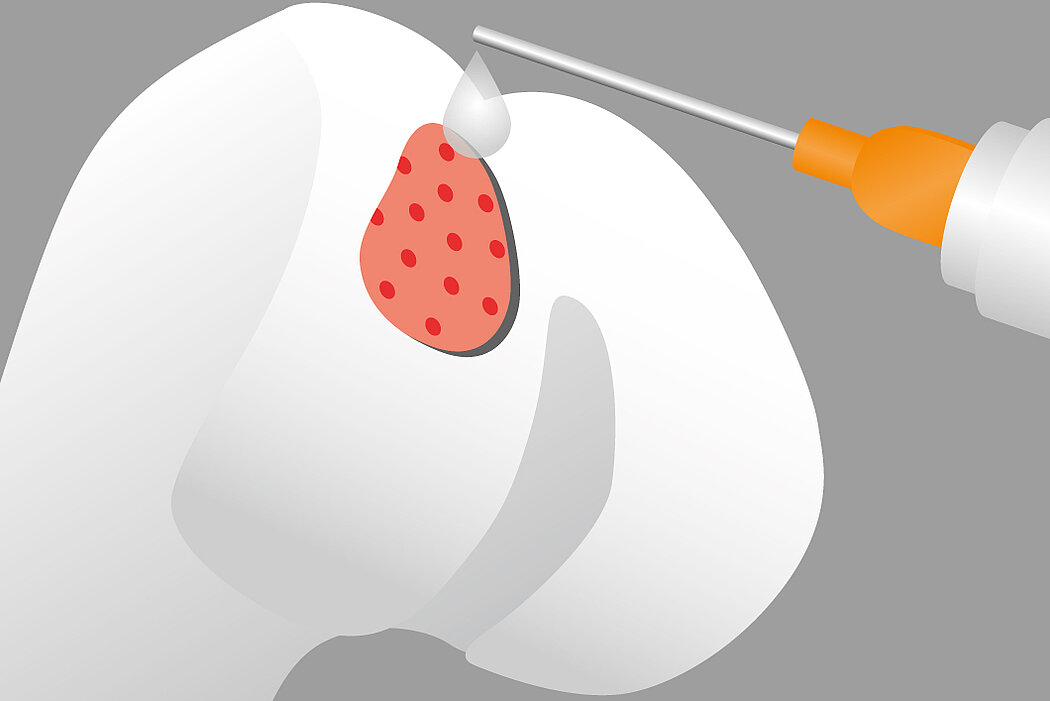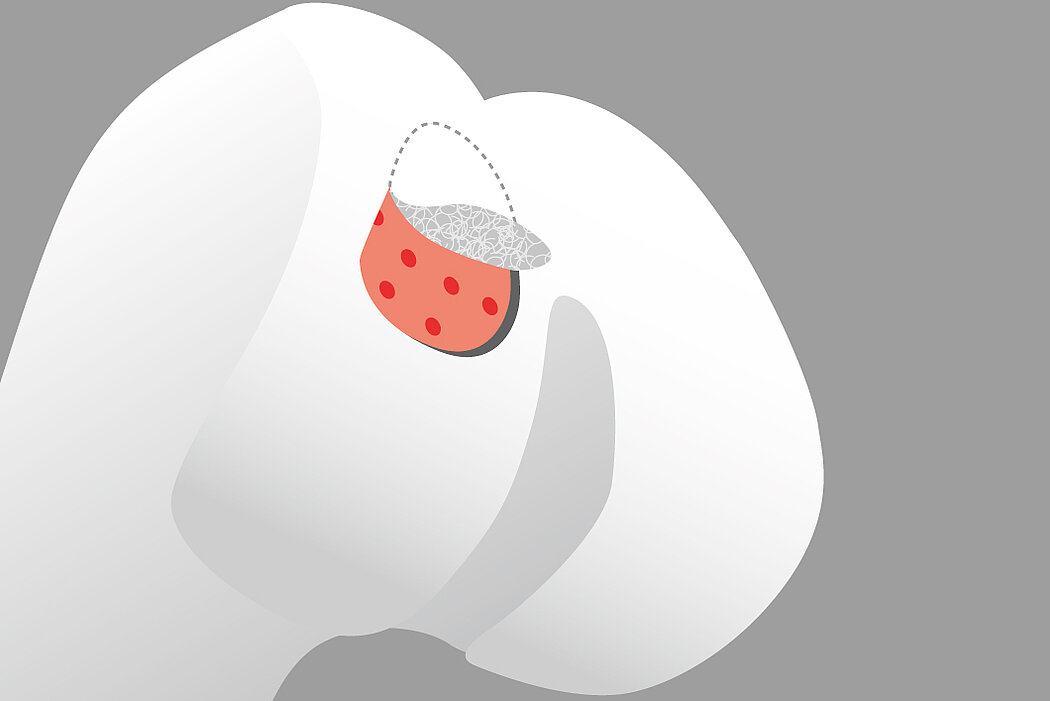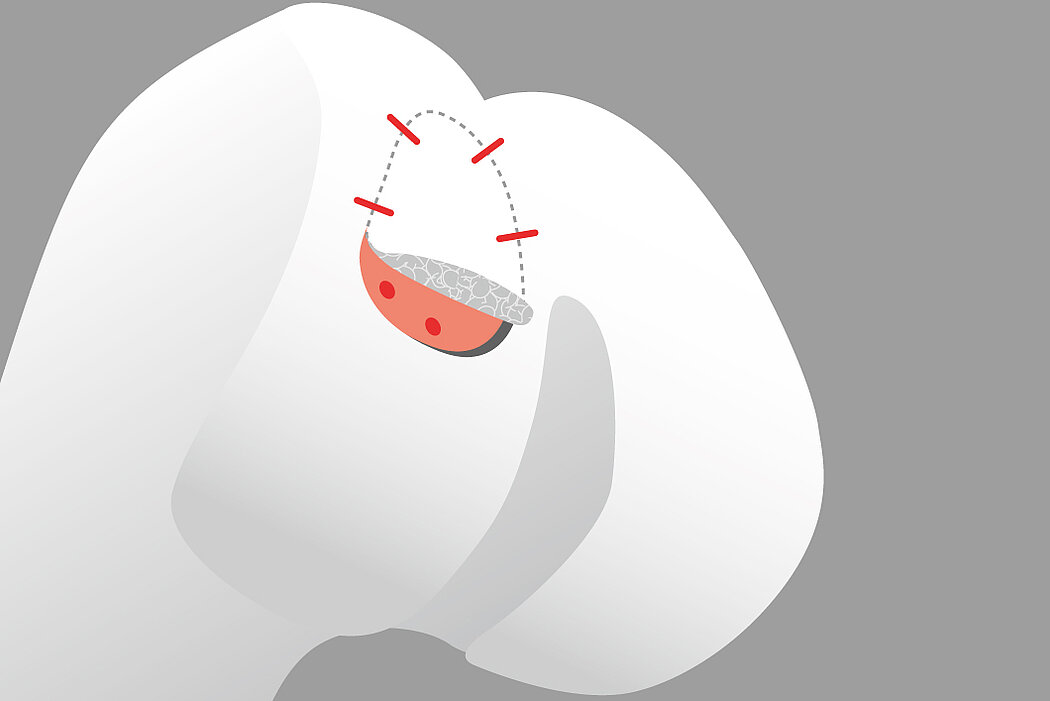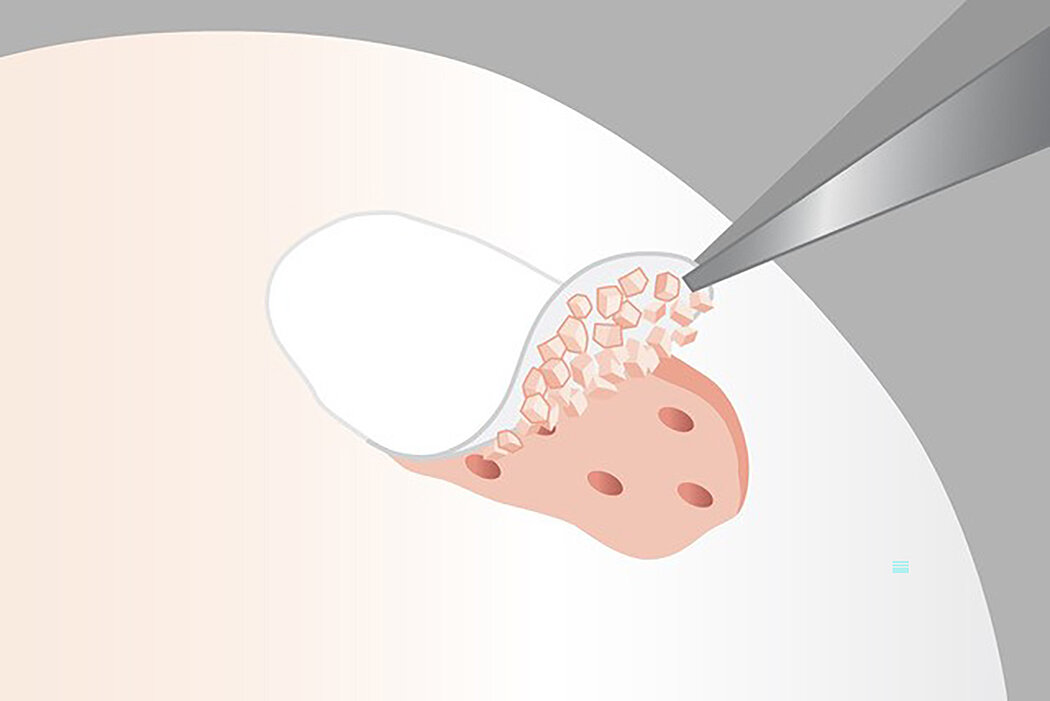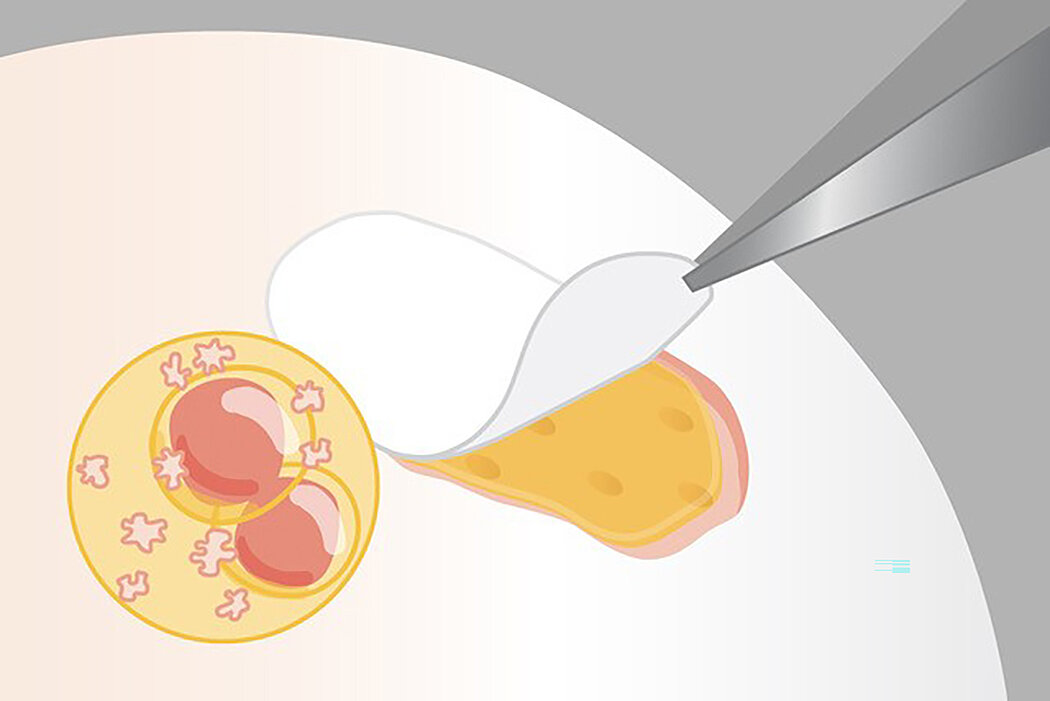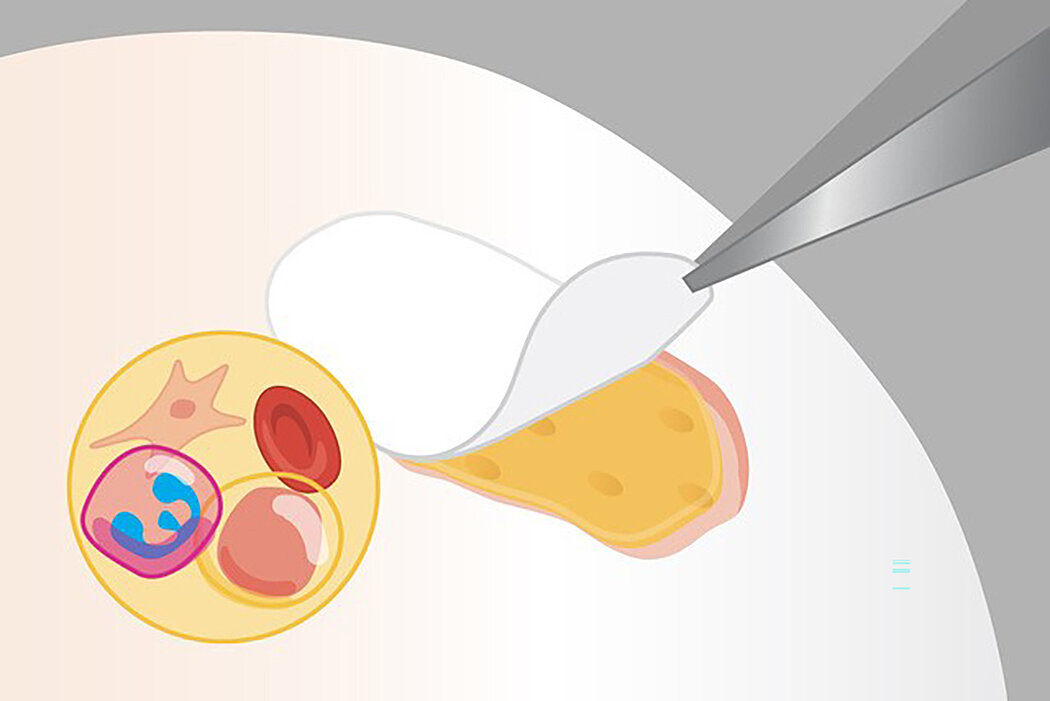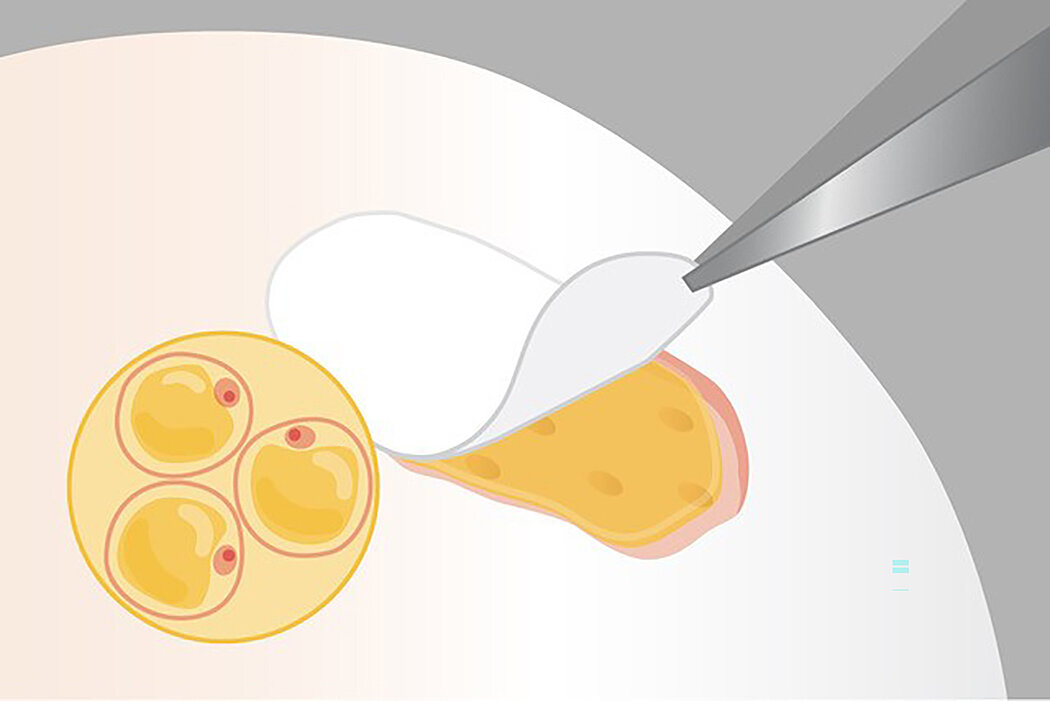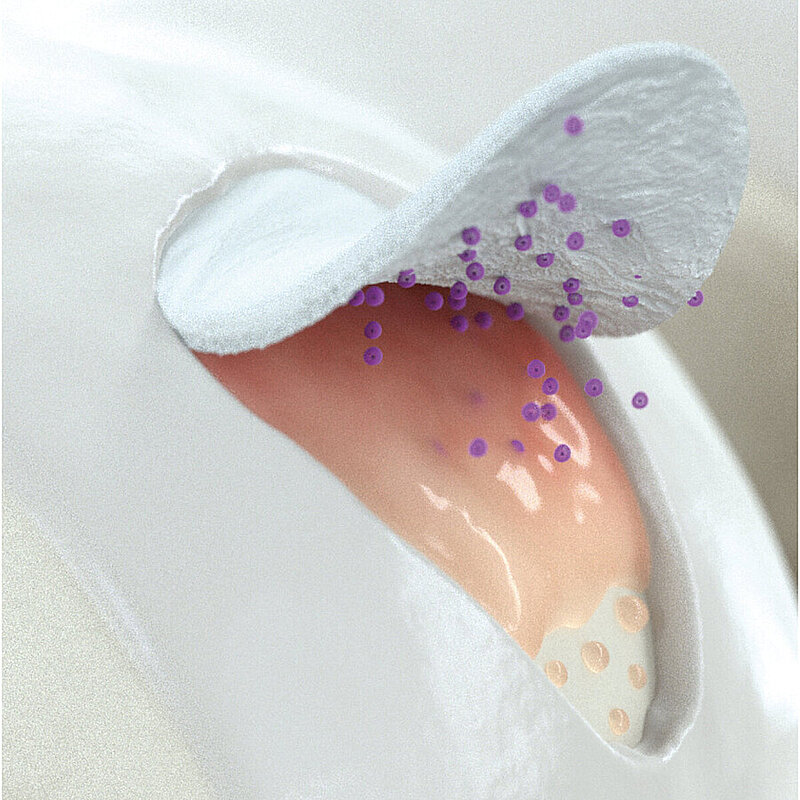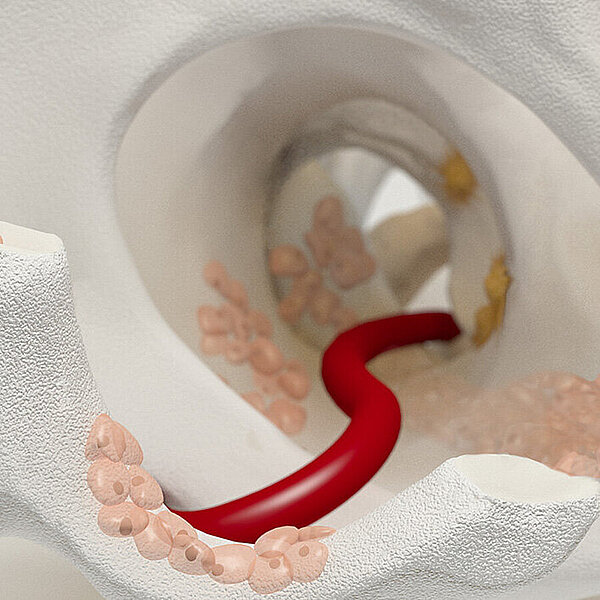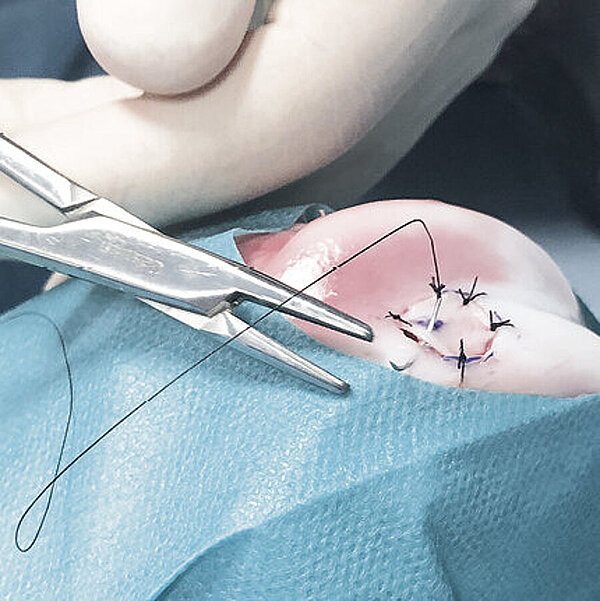AMIC® Chondro-Gide®
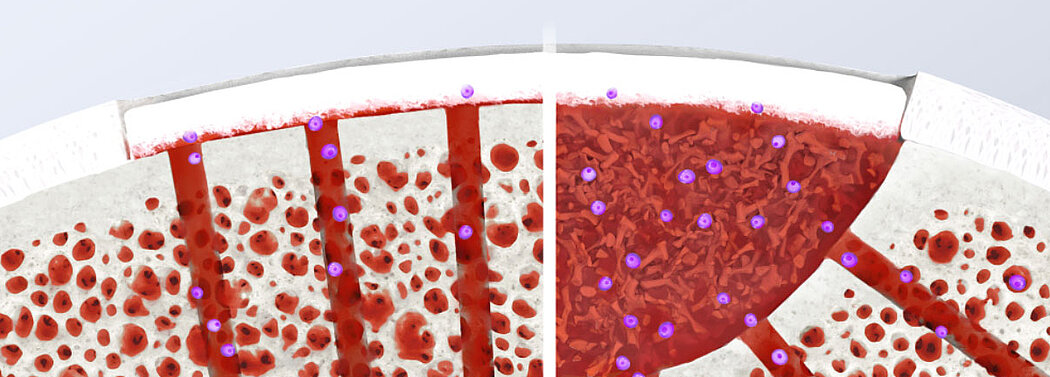
AMIC® Chondro-Gide® ist eine minimalinvasive, einzeitige Technik, die als Mini-open-Verfahren oder arthroskopisch durchgeführt werden kann. Diese Technik wurde von Geistlich Surgery in Zusammenarbeit mit führenden europäischen Chirurgen entwickelt. Seither wurde sie erfolgreich für regenerative Therapien von chondralen oder osteochondralen Defekten in Knie, Talus und Hüfte eingesetzt.1,2,3
Die Vorteile von AMIC® Chondro-Gide®
Ob minimalinvasiv oder arthroskopisch: Bei beiden Verfahren bietet AMIC® Chondro-Gide® einen einzigartigen Vorteil, indem es die Selbstheilungskräfte des Körpers unterstützt. Nach Entfernung des beschädigten Knorpels werden knochenmarkstimulierende Techniken eingesetzt, um Zellen in den Defekt zu bringen, die den Regenerationsprozess unterstützen.
Die Membran bedeckt den Defekt und dient als Schutzschild. Sie umschliesst die einwachsenden Zellen und mindert die Einwirkung von Scherkräften auf den empfindlichen Superthrombus. Gleichzeitig fungiert die Membran als Dach einer biologischen Kammer, die im Defektraum entsteht. Das biokompatible Kollagen-Material bietet so die ideale Umgebung für Zellwachstum.4
References
- VOLZ, M., et al. A randomized controlled trial demonstrating sustained benefit of Autologous Matrix-Induced Chondrogenesis over microfracture at five years. Int Orthop, Apr 2017, 41(4), 797-804) (Clinical study)
- JANELLI, E, et al. Arthroscopic treatment of chondral defects (Clinical study); in the hip: AMIC®, MACI, microfragmented adipose tissue transplantation (MATT) and other options. SICOT J, 2017, 3(43). (Clinical study)
- Geistlich Pharma AG data on file (Bench test)
- GILLE, J., et al. Cell-Laden and Cell-Free Matrix-Induced-Chondrogenesis versus Microfracture for the Treatment of Articular Cartilage Defects: A Histological and Biomechanical Study in Sheep. Cartilage OnlineFirst, January 7, 2010, doi:10.1177/1947603509358721 (Pre-clinical study)
- STEADMAN, J.R., Microfracture Technique for Full-Thickness Chondral Defects: Technique and Clinical Results. Operative Techniques in Orthopaedics. 1997. 7(4), 300-304. (Clinical study)
- STEINWACHS, M.R., et al. Matrix-associated chondroplasty: a novel platelet-rich plasma and concentrated nucleated bone marrow cell-enhanced cartilage restoration technique, Arthroscopy Techniques, 2014, (3) 2, pp e279-e282 (Clinical study)
- RICHTER, M., et al. Matrix-associated stem cell transplantation (MAST) in chondral lesions at the ankle as part of a complex surgical approach- 5-year-follow-up in 100 patients, Foot and Ankle Surgery, Volume 25, Issue 3, June 2019, Pages 264-271 (Clinical study)
- RICHTER, M. et al. Matrix-associated stem cell transplantation (MAST) versus autologous matrix induced chondrogenesis plus peripheral blood concentrate (AMIC+PBC) in chondral defects of the first metatarsophalangeal joint – A clinical cohort analysis." Fuß & Sprunggelenk, 2020, 18(3): 217-226. (Clinical study)
- DE GIROLAMO, L., et al., Autologous Matrix-Induced Chondrogenesis (AMIC) and AMIC Enhanced by Autologous Concentrated Bone Marrow Aspirate (BMAC) Allow for Stable Clinical and Functional Improvements at up to 9 Years Follow-Up: Results from a Randomized Controlled Study. Journal of Clinical Medicine. 2019. Vol. 8, no. 3, p. 392. (Clinical Study).
- GOBBI, A., et al. One-Step Cartilage Repair with Bone Marrow Aspirate Concentrated Cells and Collagen Matrix in Full-Thickness Knee Cartilage Lesions: Results at 2-Year Follow-up. Cartilage, 2011, 2(3): 286-299. (Clinical study)
- GOBBI, A., et al., One-step surgery with multipotent stem cells for the treatment of large full-thickness chondral defects of the knee. Am J Sports Med, 2011 42(3): 648-657. (clinical study)
- MASSEN, F.K., et al. One-Step Autologous Minced Cartilage Procedure for the Treatment of Knee Joint Chondral and Osteochondral Lesions: A Series of 27 Patients With 2-Year Follow-up. Orthop J Sports Med 2019 Jun 13;7(6) (Clinical study)
- SCIARETTA, F.V., One-Step Biological Resurfacing of Osteochondral Defects of the Patella, Novel Surgical Technique, Osteochondral Defects, Sphera Medical Journal, AlphaSigmaGroup, 2016
AMIC® und Chondro-Gide® – entwickelt, um die Regeneration zu unterstützen
Referenzen:
- VOLZ, M., et al. A randomized controlled trial demonstrating sustained benefit of Autologous Matrix-Induced Chondrogenesis over microfracture at five years. Int Orthop, Apr 2017, 41(4), 797-804) (Clinical study)
- JANELLI, E, et al. Arthroscopic treatment of chondral defects (Clinical study); in the hip: AMIC®, MACI, microfragmented adipose tissue transplantation (MATT) and other options. SICOT J, 2017, 3(43). (Clinical study)
- Geistlich Pharma AG data on file (Bench test)
- GILLE, J., et al. Cell-Laden and Cell-Free Matrix-Induced-Chondrogenesis versus Microfracture for the Treatment of Articular Cartilage Defects: A Histological and Biomechanical Study in Sheep. Cartilage OnlineFirst, January 7, 2010, doi:10.1177/1947603509358721 (Pre-clinical study)
- STEADMAN, J.R., Microfracture Technique for Full-Thickness Chondral Defects: Technique and Clinical Results. Operative Techniques in Orthopaedics. 1997. 7(4), 300-304. (Clinical study)
- STEINWACHS, M.R., et al. Matrix-associated chondroplasty: a novel platelet-rich plasma and concentrated nucleated bone marrow cell-enhanced cartilage restoration technique, Arthroscopy Techniques, 2014, (3) 2, pp e279-e282 (Clinical study)
- RICHTER, M., et al. Matrix-associated stem cell transplantation (MAST) in chondral lesions at the ankle as part of a complex surgical approach- 5-year-follow-up in 100 patients, Foot and Ankle Surgery, Volume 25, Issue 3, June 2019, Pages 264-271 (Clinical study)
- RICHTER, M. et al. Matrix-associated stem cell transplantation (MAST) versus autologous matrix induced chondrogenesis plus peripheral blood concentrate (AMIC+PBC) in chondral defects of the first metatarsophalangeal joint – A clinical cohort analysis." Fuß & Sprunggelenk, 2020, 18(3): 217-226. (Clinical study)
- DE GIROLAMO, L., et al., Autologous Matrix-Induced Chondrogenesis (AMIC) and AMIC Enhanced by Autologous Concentrated Bone Marrow Aspirate (BMAC) Allow for Stable Clinical and Functional Improvements at up to 9 Years Follow-Up: Results from a Randomized Controlled Study. Journal of Clinical Medicine. 2019. Vol. 8, no. 3, p. 392. (Clinical Study).
- GOBBI, A., et al. One-Step Cartilage Repair with Bone Marrow Aspirate Concentrated Cells and Collagen Matrix in Full-Thickness Knee Cartilage Lesions: Results at 2-Year Follow-up. Cartilage, 2011, 2(3): 286-299. (Clinical study)
- GOBBI, A., et al., One-step surgery with multipotent stem cells for the treatment of large full-thickness chondral defects of the knee. Am J Sports Med, 2011 42(3): 648-657. (clinical study)
- MASSEN, F.K., et al. One-Step Autologous Minced Cartilage Procedure for the Treatment of Knee Joint Chondral and Osteochondral Lesions: A Series of 27 Patients With 2-Year Follow-up. Orthop J Sports Med 2019 Jun 13;7(6) (Clinical study)
- SCIARETTA, F.V., One-Step Biological Resurfacing of Osteochondral Defects of the Patella, Novel Surgical Technique, Osteochondral Defects, Sphera Medical Journal, AlphaSigmaGroup, 2016
Aufbauend auf der etablierten AMIC® Technik, die schon eine Stimulation der regenerativen Prozesse durch BMS beinhaltet, existieren verschiedene Ansätze zur zusätzlichen Biologisierung bei der Behandlung von Knorpeldefekten. Die Palette der biologischen Faktoren, die bisher eingesetzt wurden, umfasst z.B. Platelet Rich Plasma (PRP) 6,7,8, Knochenmarkaspirat/konzentrat (BMA/C)9,10,11, mikrofragmentiertes Knorpelgewebe (Minced Cartilage = MC)12 und autologes mikrofragmentiertes Fettgewebe13. Sie wurden in verschiedenen Kombinationen mit AMIC® verwendet.
Ob diese zusätzlichen biologischen Komponenten eingesetzt werden können, hängt von den regulatorischen Vorgaben in den einzelnen Ländern ab.
References
- VOLZ, M., et al. A randomized controlled trial demonstrating sustained benefit of Autologous Matrix-Induced Chondrogenesis over microfracture at five years. Int Orthop, Apr 2017, 41(4), 797-804) (Clinical study)
- JANELLI, E, et al. Arthroscopic treatment of chondral defects (Clinical study); in the hip: AMIC®, MACI, microfragmented adipose tissue transplantation (MATT) and other options. SICOT J, 2017, 3(43). (Clinical study)
- Geistlich Pharma AG data on file (Bench test)
- GILLE, J., et al. Cell-Laden and Cell-Free Matrix-Induced-Chondrogenesis versus Microfracture for the Treatment of Articular Cartilage Defects: A Histological and Biomechanical Study in Sheep. Cartilage OnlineFirst, January 7, 2010, doi:10.1177/1947603509358721 (Pre-clinical study)
- STEADMAN, J.R., Microfracture Technique for Full-Thickness Chondral Defects: Technique and Clinical Results. Operative Techniques in Orthopaedics. 1997. 7(4), 300-304. (Clinical study)
- STEINWACHS, M.R., et al. Matrix-associated chondroplasty: a novel platelet-rich plasma and concentrated nucleated bone marrow cell-enhanced cartilage restoration technique, Arthroscopy Techniques, 2014, (3) 2, pp e279-e282 (Clinical study)
- RICHTER, M., et al. Matrix-associated stem cell transplantation (MAST) in chondral lesions at the ankle as part of a complex surgical approach- 5-year-follow-up in 100 patients, Foot and Ankle Surgery, Volume 25, Issue 3, June 2019, Pages 264-271 (Clinical study)
- RICHTER, M. et al. Matrix-associated stem cell transplantation (MAST) versus autologous matrix induced chondrogenesis plus peripheral blood concentrate (AMIC+PBC) in chondral defects of the first metatarsophalangeal joint – A clinical cohort analysis." Fuß & Sprunggelenk, 2020, 18(3): 217-226. (Clinical study)
- DE GIROLAMO, L., et al., Autologous Matrix-Induced Chondrogenesis (AMIC) and AMIC Enhanced by Autologous Concentrated Bone Marrow Aspirate (BMAC) Allow for Stable Clinical and Functional Improvements at up to 9 Years Follow-Up: Results from a Randomized Controlled Study. Journal of Clinical Medicine. 2019. Vol. 8, no. 3, p. 392. (Clinical Study).
- GOBBI, A., et al. One-Step Cartilage Repair with Bone Marrow Aspirate Concentrated Cells and Collagen Matrix in Full-Thickness Knee Cartilage Lesions: Results at 2-Year Follow-up. Cartilage, 2011, 2(3): 286-299. (Clinical study)
- GOBBI, A., et al., One-step surgery with multipotent stem cells for the treatment of large full-thickness chondral defects of the knee. Am J Sports Med, 2011 42(3): 648-657. (clinical study)
- MASSEN, F.K., et al. One-Step Autologous Minced Cartilage Procedure for the Treatment of Knee Joint Chondral and Osteochondral Lesions: A Series of 27 Patients With 2-Year Follow-up. Orthop J Sports Med 2019 Jun 13;7(6) (Clinical study)
- SCIARETTA, F.V., One-Step Biological Resurfacing of Osteochondral Defects of the Patella, Novel Surgical Technique, Osteochondral Defects, Sphera Medical Journal, AlphaSigmaGroup, 2016
Referenzen:
- VOLZ, M., et al. A randomized controlled trial demonstrating sustained benefit of Autologous Matrix-Induced Chondrogenesis over microfracture at five years. Int Orthop, Apr 2017, 41(4), 797-804) (Clinical study)
- JANELLI, E, et al. Arthroscopic treatment of chondral defects (Clinical study); in the hip: AMIC®, MACI, microfragmented adipose tissue transplantation (MATT) and other options. SICOT J, 2017, 3(43). (Clinical study)
- Geistlich Pharma AG data on file (Bench test)
- GILLE, J., et al. Cell-Laden and Cell-Free Matrix-Induced-Chondrogenesis versus Microfracture for the Treatment of Articular Cartilage Defects: A Histological and Biomechanical Study in Sheep. Cartilage OnlineFirst, January 7, 2010, doi:10.1177/1947603509358721 (Pre-clinical study)
- STEADMAN, J.R., Microfracture Technique for Full-Thickness Chondral Defects: Technique and Clinical Results. Operative Techniques in Orthopaedics. 1997. 7(4), 300-304. (Clinical study)
- STEINWACHS, M.R., et al. Matrix-associated chondroplasty: a novel platelet-rich plasma and concentrated nucleated bone marrow cell-enhanced cartilage restoration technique, Arthroscopy Techniques, 2014, (3) 2, pp e279-e282 (Clinical study)
- RICHTER, M., et al. Matrix-associated stem cell transplantation (MAST) in chondral lesions at the ankle as part of a complex surgical approach- 5-year-follow-up in 100 patients, Foot and Ankle Surgery, Volume 25, Issue 3, June 2019, Pages 264-271 (Clinical study)
- RICHTER, M. et al. Matrix-associated stem cell transplantation (MAST) versus autologous matrix induced chondrogenesis plus peripheral blood concentrate (AMIC+PBC) in chondral defects of the first metatarsophalangeal joint – A clinical cohort analysis." Fuß & Sprunggelenk, 2020, 18(3): 217-226. (Clinical study)
- DE GIROLAMO, L., et al., Autologous Matrix-Induced Chondrogenesis (AMIC) and AMIC Enhanced by Autologous Concentrated Bone Marrow Aspirate (BMAC) Allow for Stable Clinical and Functional Improvements at up to 9 Years Follow-Up: Results from a Randomized Controlled Study. Journal of Clinical Medicine. 2019. Vol. 8, no. 3, p. 392. (Clinical Study).
- GOBBI, A., et al. One-Step Cartilage Repair with Bone Marrow Aspirate Concentrated Cells and Collagen Matrix in Full-Thickness Knee Cartilage Lesions: Results at 2-Year Follow-up. Cartilage, 2011, 2(3): 286-299. (Clinical study)
- GOBBI, A., et al., One-step surgery with multipotent stem cells for the treatment of large full-thickness chondral defects of the knee. Am J Sports Med, 2011 42(3): 648-657. (clinical study)
- MASSEN, F.K., et al. One-Step Autologous Minced Cartilage Procedure for the Treatment of Knee Joint Chondral and Osteochondral Lesions: A Series of 27 Patients With 2-Year Follow-up. Orthop J Sports Med 2019 Jun 13;7(6) (Clinical study)
- SCIARETTA, F.V., One-Step Biological Resurfacing of Osteochondral Defects of the Patella, Novel Surgical Technique, Osteochondral Defects, Sphera Medical Journal, AlphaSigmaGroup, 2016
Während die biologischen Faktoren und ihre Kombinationen bei den neuen AMIC®+-Ansätzen variieren, setzen alle Techniken Chondro-Gide® ein, um die Zellen an Ort und Stelle zu halten und eine biologische Kammer zu schaffen, die das Regenerat schützt und das Heilungspotenzial des Körpers unterstützt. Zukünftige Studien werden zeigen, ob die Zugabe von einem oder mehreren biologischen Faktoren die Knorpelreparatur im Vergleich zur etablierten AMIC® verbessern kann.
References
- VOLZ, M., et al. A randomized controlled trial demonstrating sustained benefit of Autologous Matrix-Induced Chondrogenesis over microfracture at five years. Int Orthop, Apr 2017, 41(4), 797-804) (Clinical study)
- JANELLI, E, et al. Arthroscopic treatment of chondral defects (Clinical study); in the hip: AMIC®, MACI, microfragmented adipose tissue transplantation (MATT) and other options. SICOT J, 2017, 3(43). (Clinical study)
- Geistlich Pharma AG data on file (Bench test)
- GILLE, J., et al. Cell-Laden and Cell-Free Matrix-Induced-Chondrogenesis versus Microfracture for the Treatment of Articular Cartilage Defects: A Histological and Biomechanical Study in Sheep. Cartilage OnlineFirst, January 7, 2010, doi:10.1177/1947603509358721 (Pre-clinical study)
- STEADMAN, J.R., Microfracture Technique for Full-Thickness Chondral Defects: Technique and Clinical Results. Operative Techniques in Orthopaedics. 1997. 7(4), 300-304. (Clinical study)
- STEINWACHS, M.R., et al. Matrix-associated chondroplasty: a novel platelet-rich plasma and concentrated nucleated bone marrow cell-enhanced cartilage restoration technique, Arthroscopy Techniques, 2014, (3) 2, pp e279-e282 (Clinical study)
- RICHTER, M., et al. Matrix-associated stem cell transplantation (MAST) in chondral lesions at the ankle as part of a complex surgical approach- 5-year-follow-up in 100 patients, Foot and Ankle Surgery, Volume 25, Issue 3, June 2019, Pages 264-271 (Clinical study)
- RICHTER, M. et al. Matrix-associated stem cell transplantation (MAST) versus autologous matrix induced chondrogenesis plus peripheral blood concentrate (AMIC+PBC) in chondral defects of the first metatarsophalangeal joint – A clinical cohort analysis." Fuß & Sprunggelenk, 2020, 18(3): 217-226. (Clinical study)
- DE GIROLAMO, L., et al., Autologous Matrix-Induced Chondrogenesis (AMIC) and AMIC Enhanced by Autologous Concentrated Bone Marrow Aspirate (BMAC) Allow for Stable Clinical and Functional Improvements at up to 9 Years Follow-Up: Results from a Randomized Controlled Study. Journal of Clinical Medicine. 2019. Vol. 8, no. 3, p. 392. (Clinical Study).
- GOBBI, A., et al. One-Step Cartilage Repair with Bone Marrow Aspirate Concentrated Cells and Collagen Matrix in Full-Thickness Knee Cartilage Lesions: Results at 2-Year Follow-up. Cartilage, 2011, 2(3): 286-299. (Clinical study)
- GOBBI, A., et al., One-step surgery with multipotent stem cells for the treatment of large full-thickness chondral defects of the knee. Am J Sports Med, 2011 42(3): 648-657. (clinical study)
- MASSEN, F.K., et al. One-Step Autologous Minced Cartilage Procedure for the Treatment of Knee Joint Chondral and Osteochondral Lesions: A Series of 27 Patients With 2-Year Follow-up. Orthop J Sports Med 2019 Jun 13;7(6) (Clinical study)
- SCIARETTA, F.V., One-Step Biological Resurfacing of Osteochondral Defects of the Patella, Novel Surgical Technique, Osteochondral Defects, Sphera Medical Journal, AlphaSigmaGroup, 2016

